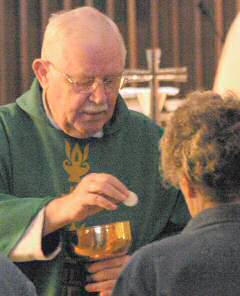 It's no secret that the U.S. Catholic church has comparatively fewer priests than it had 40 years ago. So how are Catholics responding? Melanie Lefkowitz of Newsday wrote about one response: an influx of older seminarians and priests entering the ministry.
Lefkowitz began her story in appropriate fashion. She profiled Robert Holz, a 40-year-old former accountant who typifies the trend:
It's no secret that the U.S. Catholic church has comparatively fewer priests than it had 40 years ago. So how are Catholics responding? Melanie Lefkowitz of Newsday wrote about one response: an influx of older seminarians and priests entering the ministry.
Lefkowitz began her story in appropriate fashion. She profiled Robert Holz, a 40-year-old former accountant who typifies the trend:
Holz is among a vanguard of older priests-in-training who are energizing an institution that has faced stiff recruitment challenges for decades.
He's one of nine men expected to be ordained this June, in what church officials say is among the largest classes of incoming priests in the nation. At its low nine years ago, the Rockville Centre Diocese ordained one priest.
Lefkowitz also put the priest shortage in the proper context. Using some of the best statistics on the problem I have seen, Lefkowitz noted not only the drop off today but also in the future:
New priests of any age are sorely needed. As the number of Catholics in the United States has risen, the number of priests has steadily dropped. According to the United States Conference of Catholic Bishops, there are nearly 29,000 priests, about 20% fewer than 40 years ago.
But the worst is probably still ahead. The decline in the number of ordinations nationwide -- 475 in 2007, compared with 994 in 1965 -- and the aging of the current population of priests, whose median age is in the 50s, indicate that the priest shortage will grow more critical.
Lefkowitz adds that the number of seminarians in the Rockville diocese rose to 31 from a figure in the single digits. So how did the new bishop achieve this feat? Here is Lefkowitz's answer:
The Sept. 11 attacks helped to inspire some of these men to enter the priesthood; for others, the balance swung after an illness or the loss of a parent. Many said they considered the priesthood as young children but were distracted, uncertain or afraid.
In other words, Lefkowitz did not answer the question. But the answer is surely a big part of the story. The number of seminarians more than tripled in seven years.
Did church officials tap into the spiritual and cultural unease that Holz felt? I bet that the ordinary, Bishop William Bishop, did. After all, the story notes that Murphy made "the priesthood a priority."
Every reporter knows that the culture impact the church. Yet it's also true that the church impacts the culture. Had this fact been incorporated, Lefkowitz's story would have been better.
